All about St Lucia: interesting facts about the country
St Lucia is an island state next to South America. Its economy is based on tourism, agriculture and foreign investment.

Investment programs expert
Fact checked byAlbert Ioffe
Reviewed byVladlena Baranova

All about St Lucia: interesting facts about the country
Share:
Foreign citizens who are granted a second citizenship by investment in St Lucia can travel without a visa to 146 countries around the world, including the Schengen states, Britain, Andorra and Singapore.
In this article we write about St Lucia, its tourist attractions, how the local population lives and how much it costs to holiday on one of the favorite islands of American tourists.
Facts about St Lucia
History of St Lucia
The island was named St Lucia by Christopher Columbus in honor of the Roman saint, Lucia. Columbus discovered the island on December 13, 1502, on St Lucia’s commemoration day. The Arawaks and Caribbean Indians had originally named the island Lyonola and Hewanorra, which in their languages means “there where iguanas are found.”
At the beginning of the 17th century, the first European settlers arrived in St Lucia and immediately began to fight with the locals for land. In 1643, French officers signed an agreement with the Caribbean and founded the first settlement. At the same time, Europeans began to bring slaves to the island from Africa.
In 1651, fighting broke out between the French and the British for the right to own the island. The British finally won in 1814 and colonized the Caribbean state.
St Lucia was part of the British colony of the Windward Islands for over a hundred years. The country gained independence on February 22, 1979 and has since been considered a sovereign state of the British Commonwealth.
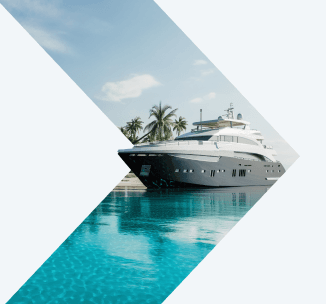

Are you a perfect fit for Caribbean citizenship?
Discover your eligibility with our simple quiz!
Political and economic structure of St Lucia
Political structure. St Lucia is a parliamentary monarchy. Officially, the monarch of Britain, Queen Elizabeth II, is the head of state, and her interests in the country are represented by the gove or-general.
Parliament consists of the House of Assembly and the Senate and exercises legislative power in the state. The executive power is in the hands of the cabinet of ministers.
The St Lucia judicial system is part of the Eastern Caribbean judicial system, which is chaired by the Eastern Caribbean Supreme Court. It consists of the Court of Appeal and the High Court. Sessions of the Court of Appeal are offsite and take place on the territory of the country. St Lucia also has a magistrates' court and a High Court Judge's Secretariat.
Official websites of St Lucia

The flag depicts the Piton Mountains as a symbol of citizens’ hope for a better life. The blue colour indicates loyalty, yellow is a sign of the sunny weather on the island, and black with white edges means the peaceful coexistence of dark- and white-complexioned people
The economy of the country is dependent on tourism, agriculture, fishing and the citizenship by investment program.
Tourism contributes about 50% of St Lucia’s GDP per annum. As the government is interested in the development of the tourism industry, it invests in the construction of urban infrastructure: earthquake-resistant houses, hotels, embankments and roads.
In the valleys among the mountains, there are fruit plantations of bananas, mangoes, oranges, grapes, coconuts and cocoa. The government exports fruit to the United Kingdom and the United States, and also maintains trade relations with other countries in the Caribbean region.
St Lucia launched its Citizenship by Investment Program in 2014. The income from the program has helped the government to increase investment in tourism, the urban infrastructure and social life of the population.
Population. About 85% of the inhabitants of the island are of African descent, 14% are descendants of the Arawak and Caribbean Indians, and the remaining 1% of the country's population consists of European and Asian immigrants.
The official language of the country is English, but amongst themselves locals often use the Creole language, which is derived from French.
Religion. About 91% of the population of St Lucia is Christian: Anglican, Methodist and Catholic. 6% of residents indicated in the census that they were atheists. 2.5% of the population adheres to the folk beliefs of their ancestors. Followers of Hinduism and Islam can also be found on the island.
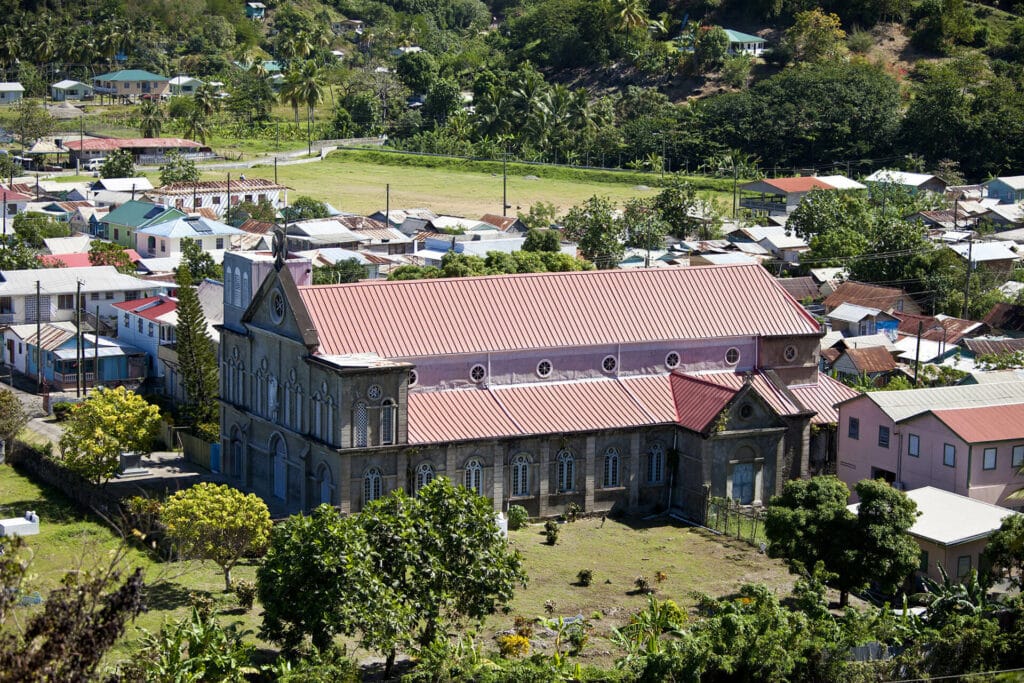
Catholic church in Anse la Rey, St Lucia. The chapel was built by the French in 1765 and the church was added in 1907. Inside the church, there are frescoes painted by the family of St Omer.
What does St Lucia citizenship offer investors?
St Lucia citizens can freely travel to 146 countries without a visa, including the Schengen states, the European Union, the United Kingdom and Singapore.
St Lucia citizens can apply for a 10-year visa to the United States using a simplified procedure. In contrast, citizens from a number of other countries are issued such a visa for a maximum of three years and registration can take up to three months.
The St Lucia Citizenship by Investment Program has been in operation since 2014. It ranks fourth in the global ranking of citizenship by investment programs in 2021. The cost of obtaining citizenship in the Caribbean is half or a third of the cost of citizenship by investment programs in Europe.
The government of St Lucia offers investors four investment options.
Investment options for the St. Lucia citizenship program
The bonds can be fully redeemed 5 years later and the money invested returned to the investor.
In addition to the investment, the investor pays state duties, administrative fees, a fee for the Due Diligence check and an administrative fee. The total amount depends on the members of the investor’s family included in the application and their age.
Comparison of St Lucia citizenship with other Caribbean passports
If you consider obtaining a St Lucia passport, these materials will help you understand how it compares to other Caribbean passports, highlighting the unique benefits and requirements of each:
Life in St. Lucia
Tourists are attracted by the exotic nature and distinctive way of life of the local population. Holidays on the islands provide an opportunity to temporarily integrate into the society and culture of St Lucia: travelers use public transport, rent accommodation and cars, and go shopping in local shops.
Infrastructure. There are two airports in the country: Hewanorra, which is located 54 kilometers from Castries, and George F.L. Charles Airport, which is located 2 kilometers from the capital. There are direct flights to St Lucia from the UK, United States, Canada and the Caribbean.
Visitors from other countries need to either change flights on their journey or arrive on a cruise ship. The time difference between the UK (Greenwich mean time) and Castries is 5 hours.
The cruise port is located two kilometers from the center of Castries, the capital of St Lucia. Off the coast of the island, there are public and private marinas with varying levels of amenities. Rodney Bay, the famous marina, is located in Gros Islet, where the Atlantic Rally ends. The rally starts in Spain and about 200 yachts take part in the 5000 km-long transatlantic sailing competition to the Caribbean.
St Lucia has a developed tourist infrastructure, including hotels, restaurants, golf, tennis and horse riding clubs. Local travel agencies offer tourists to enjoy boat trips, car tours around the island and tours of the tropical jungle. Outdoor sport enthusiasts also have the opportunity to go kayaking, diving and surfing.

From George F. L. Charles Airport the most frequent flights are to the Caribbean. For example, it takes 45 minutes to fly to Barbados in 45 minutes for $200
Prices and living costs in St Lucia are lower than in Europe. A three-course dinner for two at a mid-range restaurant costs $42.5. For comparison, a similar meal costs $70 in Malta.
Buying food at a local store and preparing lunch will cost about the same as a meal at a restaurant:
-
bread, 500 g: $0.8;
-
milk, 1 l: $ 2.7;
-
local cheese, 1 kg: $10.5;
-
eggs, 1 dozen: $2.7;
-
chicken fillet, 1 kg: $11.2;
-
potatoes, 1 kg: $2.3;
-
tomatoes, 1 kg: $5.5;
-
oranges, 1 kg: $1.7;
-
bananas, 1 kg: $1.3;
-
a bottle of mid-priced wine: $9.5.
A subscription for a month of classes in a local fitness club costs at least $36, renting a tennis court for an hour costs $55, and a ticket to the cinema costs $7.
Real estate. Travelers are more likely to stay in hotels, but some visitors rent houses and apartments from local residents. The rental price depends on the region of the country. The average price for a one-bedroom apartment is $262 per month, according to numbeo.com.
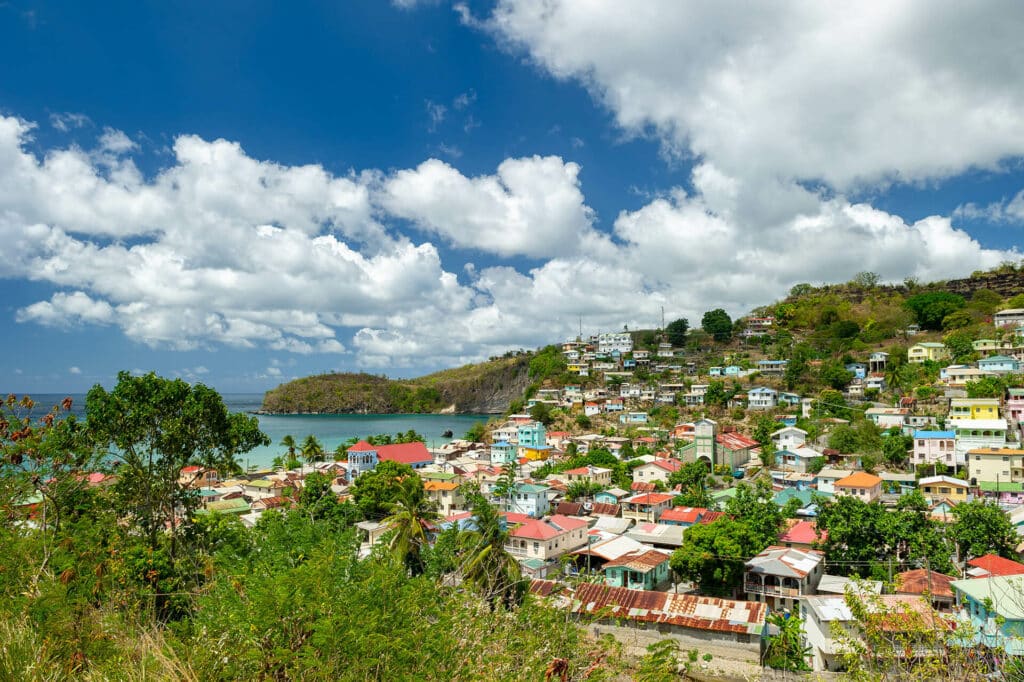
Hotels, villas and apartments are usually located near the coast. In the cities, apartments can be rented in houses built in different periods; for example, colonial or modern
Taxes. St Lucia citizens do not pay taxes on income or capital that they receive outside the country. There are no taxes on wealth, inheritance or capital gains.
Basic taxes for individual citizens
Basic taxes for legal entities
Transport. Buses run between the cities and towns of St Lucia; the cost of one trip is about a dollar. For a taxi, the price per kilometer is at least $0.75.
The island has good asphalt roads. Local firms offer cars for rent. Driving in St Lucia is on the left hand side of the road.
Ferry services are available between St Lucia and other Caribbean islands. The fares depend on the season.

An international driving license is required to drive around the island by car. It takes 5-6 hours to travel around most of St Lucia by car
Education. St Lucia’s public schools provide free education for all students. Private schools and international colleges can be found in large cities.
There are four universities in the country. The British University of the West Indies is more popular: a branch has been opened in St Lucia. The campus of the university is located in Castries. The branch is based on British educational standards.
At Sir Arthur Lewis University, students study mathematics, tourism, arts, and nursing. Tuition prices start at $1,350 per annum.
St Lucia citizens have the right to study in UK universities on preferential terms, since the country is part of the Commonwealth of Nations.
Medicine. Hospitals in St Lucia offer British treatment standards. The modern clinics in the country offer the local population almost all types of medical services.
For complex surgeries, such as joint arthroplasty or internal organ transplants, St Lucians travel to the United States, Canada or the United Kingdom.
Many hotels have English-speaking doctors available. The cost of an examination is at least $15. Foreigners need to pay for medical treatment in St Lucia, and it is advisable to take out international medical insurance before their trip.
Sightseeing and activities
St Lucia combines the culture of several countries: the heritage of the Arawak and Caribbean Indians, the life experience of the African people and the customs of European settlers.
The main attractions. The twin mountains of Piton are the most popular site on the island. They are located next to the Caribbean coast and encircle a small picturesque bay. Exotic plants grow on the mountain slopes, which can be seen from the sea or when hiking.
Sulfur fumaroles and thermal springs have formed on the slopes and at the foot of the mountains. Anyone can take a mud bath and swim in one of the springs.
Pigeon Island National Park in the north of St Lucia attracts lovers of sea sports: tourists come for snorkeling, sailing and diving. The island is home to the ruins of Fort Rodney, which was built by the British to fight the French.
Soufrière is the former capital of St Lucia, founded by the French. Tourists come to the city to see colonial estates such as the Fond Doux estate. It used to belong to King Louis XIV. Now it is a resort plantation, which has a chocolate factory, famous not only on the island but also in London. Cocoa for chocolate is grown nearby on the plantation.
The Government House in Castries, the capital of the state, is the official residence of the Governor General. The building was restored several times after being destroyed by hurricanes. In 1894, the house was fundamentally reconstructed: the house was made earthquake-resistant and the wooden walls were replaced with bricks.

Pigeon Island was artificially annexed to St Lucia in 1972 and became a national landmark in 1992. In the 17th century, the famous pirate Jambe de Bois ambushed Spanish merchant ships on the island. Today the St. Lucia Jazz Festival, which attracts jazz lovers from all over the world, is held here.
Events. Festivals, national holidays and celebrations of prominent people in the country are held annually in St Lucia. On ordinary days, parkour and dance competitions are organized on the streets, and once a week there are fried fish evenings.
❄ In winter, the achievements of St Lucia’s two Nobel laureates, Sir Arthur Lewis, who received the Prize in Economics in 1979, and Sir Derek Walcott, who won the 1992 Prize for Literature, are celebrated.
On February 22, the inhabitants of the island celebrate their Independence Day, which the country received in 1979.
There are music festivals on the island in spring: jazz lovers gather for the main jazz festival of the Caribbean islands. Local performers and world stars perform at the festival. Elton John, Rihanna, Herbie Hancock and Lauryn Hill have all performed at the festival in April. The festival features calypso, jazz and R&B music.
☀ In the summer, the TRI St Lucia triathlon is held in St Lucia. On the last Sunday in June, fishermen celebrate Fête Pêche or Fishermen's Day. Special services are held in local churches and a series of festive feasts are held in the city.
Carnivals are also held in June: beach parties, parades, and concerts conducted by local bands and DJs are held on the island. The most popular holidays are Power and Groovy Monarch, Senior and Junior Panoramas, and Inter-Commercial House Calypso.
Mercury Fest is the main party of the summer. Thousands of people come to St Lucia from all over the world for a two-day party on Pigeon Island. During the day, sea and beach competitions are held, and in the evening, international pop stars perform on the seashore.
In August, the flower festivals La Rose and La Marguerite are held in St Lucia. Residents admire the nature of their native island and the distinctive culture of all the peoples of the country. The island also hosts the Wellness Music Festival. It promotes healthy lifestyles and famous artists from St Lucia perform for guests.
Creole Day is celebrated in autumn. Since October 1981, the tradition of honoring the island’s French heritage has turned into a month of art, music, dance and cuisine. In the middle of autumn there is also a fishing tournament in IGY Rodney Bay Marina. About 130 fishermen from the UK, United States, Antigua, Martinique, Barbados and Grenada come to St Lucia to compete and win the best fisherman award.
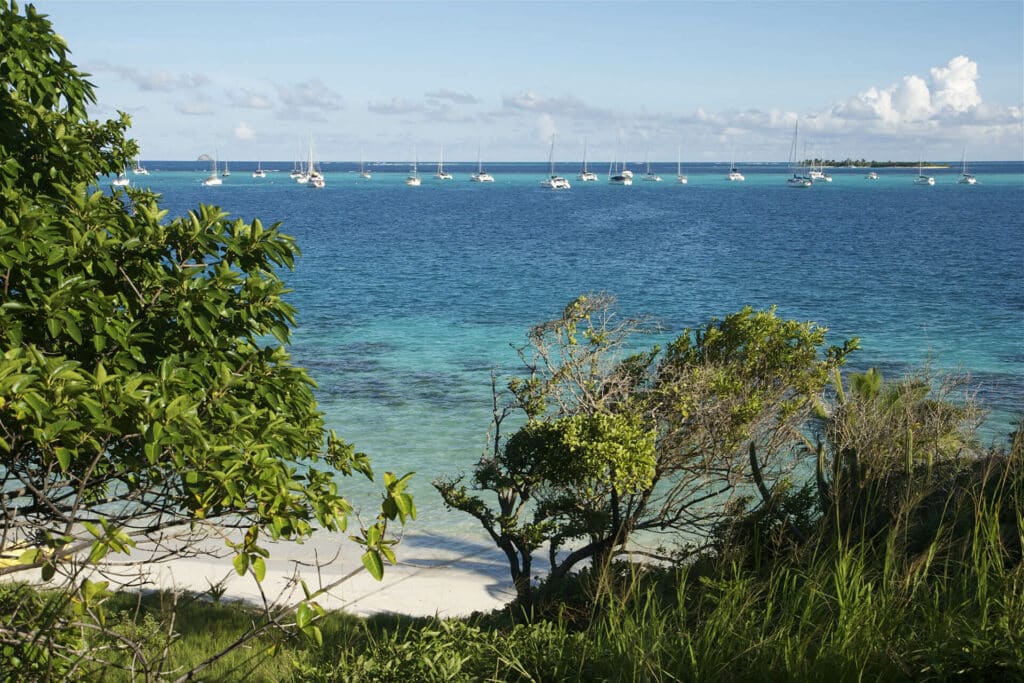
At the end of November, Rodney Bay hosts the Mango Bowl Regatta, which brings together local sailors from all the Caribbean for three days
St Lucia: geography and nature
The island of St Lucia was formed after the eruption of an underwater volcano in the Atlantic Ocean. The western erritory of St Lucia is washed by the waters of the Caribbean Sea.
The relief of the island is mountainous: the Barre de L'Isle Ridge mountain range runs through the center. The highest mountain in the country is Gimie; its peak reaches 950 m above sea level. Foreign medical tourists are attracted to the hot sulfur springs, mineral lakes and lava fields that have formed at the foot of the mountains and on the hills.
The country has a tropical trade wind climate. The air temperature ranges from +23 to +31°C throughout the year and rarely drops below this range. The air is humid. The rainy season is from June to December, when hurricanes and earthquakes hit the island.
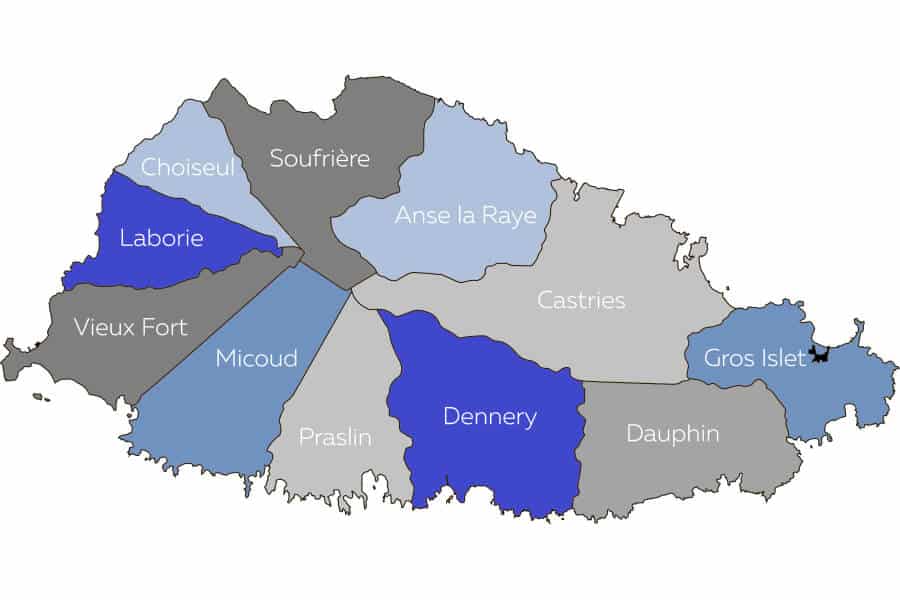
St Lucia is divided into 11 parishes. A third of the population lives in the capital, Castries
St Lucia is home to the world-famous Piton Mountains or the twin peaks. They rise above the coast and enclose a small picturesque bay.
The island is covered with tropical forests and plants. Shallow rivers flow down the slopes of the mountains, dividing the land into fertile valleys. Among the forests, the locals have established fruit plantations and grow bananas, coconuts, annona and mangoes there.

There are many hiking trails in St Lucia: hikers can walk through the jungle, climb the mountains or walk to the waterfalls
Most of St. Lucia's wildlife is protected. There are about 400 species of plants on the island, including various shrubs, palms and rare species of orchids. Tourists and residents of the island can visit nature reserves, national parks, botanical gardens and Pigeon Island.
The fauna of the island is represented mainly by birds and rodents. The most famous bird of the island is the blue-fronted Amazon. This type of parrot is found only in St Lucia. Turtles can be found along the coast. Whales and dolphins periodically swim around the island.
There are about 450 species of fish in the Caribbean Sea, of which 168 are found on the west coast of the island among coral reefs. Tourists come to St Lucia for spear fishing and excursions on the sea, where they can also see cnidarians, molluscs and echinoderms.
Immigrant Invest is a licensed agent for citizenship and residence by investment programs in the EU, the Caribbean, Asia, and the Middle East. Take advantage of our global 15-year expertise — schedule a meeting with our investment programs experts.

Practical Guide
Will you obtain St Lucia citizenship?
-
Master the residency process
-
Get expert tips and documents
-
Estimate costs accurately
















